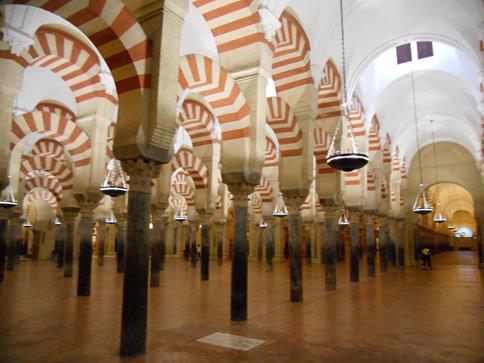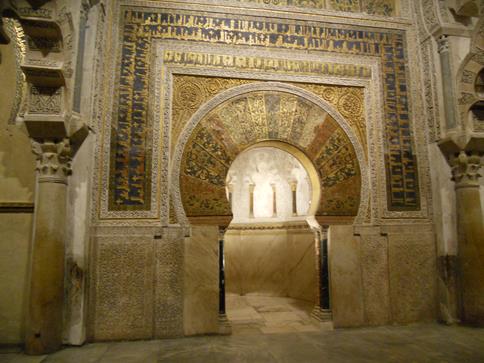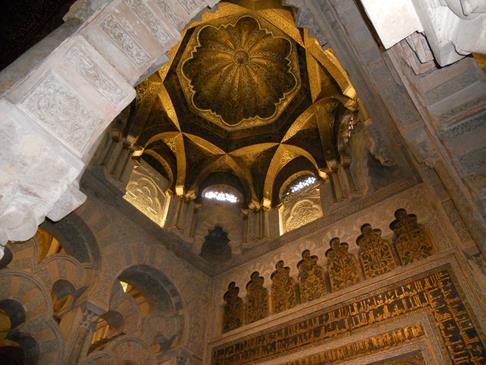The Great Mosque of Córdoba (la Mezquita), together with the Alhambra Palace in Granada, are the most important architectural legacies of medieval al-Andalus. The Great Mosque was constructed between 785 and 987 C.E. and even today remains one of the largest mosques ever constructed. Its distinctive red-and-white double horseshoe columns are iconic in medieval Islamic architecture. I visited the Great Mosque in the fall of 2010 while doing research for Emeralds of the Alhambra. Wow! I arrived just after sunrise, before the crowds descended. It was a magical moment, a chance to travel back in time, to imagine. An unforgettable experience. Below are some pictures of the interior as well as an impressionist scene excerpted from book two of the “Anthems of al-Andalus” Series, Shadows on the Shining City.

Interior view of the double-arched interior.

The mihrab, constructed by Caliph al-Hakam II in the late 10th century Córdoba (the setting for Shadows in the Shining City). Over 1800 kg of gold and tons of mosaics were sent as a gift by the Byzantine emperor to help complete the structure.

The gold dome rising above the mihrab.
The second novel in the “Anthems of al-Andalus” series is set in late 10th century Córdoba, at the height of the Umayyad Golden Age (when la convivencia (coexistence) reigned).
Excerpt from Shadows in the Shining City, by John D. Cressler, coming 2014 from Sunbury Press.
“The doubled-tier of arches floats upon marble columns slender as a young girl, evoking a dense forest of date palms ringing a lush oasis in the Syrian desert. The trees are endless, stunning in their uniformity, the view from any vantage upon the floor identical. Umayyad horseshoes, commandeered from the ancient Visigoths and perfected, visually arresting in their alternating bands of red and white, the colors of the Caliph.
The doubled-horseshoes join forces to disperse and break the weight of the low ceiling, producing a complex play of light upon shadow, sound upon silence, a paradox of intimacy bounded by such a vast open space.
There is some magical architectural abstraction at work in the forest of Umayyad palms, a labyrinth without walls, a spatial arabesque of red and white that shouts its metaphor, the infinity of Allah. The worshipper praying at any location in the giant structure resides at the very center of the cosmos, a mirror to Allah’s desired union, Creator with his creation, at one instance of time, at one location in space, there to stretch out in all directions, for all eternity. This is a temple of prayer. This is a communion of souls.
The floor of the great space is a sea of woven hemp, the shifting sands of an endless desert. Rows of the prostrate faithful stretch straight as arrows, hundreds times hundreds. Their foreheads and palms are flat to the sand, the ocean of souls gathered in perfect symmetry about the breathtaking mihrab of Byzantine gold and cobalt mosaics, a pathway opened to Mecca.
The Grand Imam proclaims, “Subhana rabbi al-a la wa-bi-hamdih.” Glory to my Lord, the Most High, the Most Praiseworthy. Thousands of whispers coalesce in echo. Again. A third time. Then the Grand Imam says, “Allahu akbar!” God is Great! Deafening roar. Hundreds times hundreds rise into a kneeling posture as a single organism.”
beautiful!!